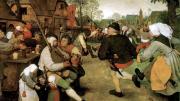Health Care Reform, by Jonathan Gruber, Ph.D. ’92, with HP Newquist, illustrated by Nathan Schreiber (Hill and Wang, $30; $13.95 paper). Think “Healthcare reform: the comic book.” An illustrated guide to the new law by the MIT professor of economics who advised former Massachusetts governor Mitt Romney, M.B.A. ’74, J.D. ’75 (and later the U.S. government) on combining insurance reform, a coverage mandate, and subsidies for lower-income people to make insurance universal.
Remedy and Reaction: The Peculiar American Struggle over Health Care Reform, by Paul Starr, Ph.D. ’78, JF ’78 (Yale, $28.50). Not a comic book, this is a detailed, serious analysis of American exceptionalism concerning the delivery and politics of healthcare. Starr, a professor at Princeton, won the Pulitzer and Bancroft prizes for The Social Transformation of American Medicine (1984), still the classic work in the field.
Pieter Bruegel, by Larry Silver, Ph.D. ’74 (Abbeville, $150). A magnificent volume on the Netherlandish painter by the Farquhar professor of art history at Penn, in a lush large format (with reproductions of all the surviving paintings) that makes visible the craft and imagination in Bruegel’s hellish, quotidian, and amusing compositions of crowds and compelling individuals.
Guantánamo: An American History, by Jonathan M. Hansen, lecturer on social studies (Hill and Wang, $35). A deep dive into the place that has become since 9/11 the complicated center of the uncertain intersection of U.S. law and sovereignty.
Knocking on Heaven’s Door, by Lisa Randall, Baird professor of science (Ecco, $29.99). The author, who unusually combines string theory with writing for the wider public, here ranges widely over hard problems addressed by the Large Hadron Collider, and harder ones involving cosmology, the nature of science, and belief.
The Back Chamber, by Donald Hall ’51, JF ’57 (Houghton Mifflin, $22). A new collection of nearing-the-end-of-life works by the 2006-2007 U.S. poet laureate.
Conversations with Michael Crichton [’64, M.D. ’69], edited by Robert Golla (University Press of Mississippi, $55; $25 paper). The late, bestselling author (The Andromeda Strain, Jurassic Park, etc.) and climate-change skeptic, in interviews with the New York Times, Playboy, and more.
Strange Relation: A Memoir of Marriage, Dementia, and Poetry, by Rachel Hadas ’69 (Paul Dry, $16.95 paper). The author, a professor of English at Rutgers, movingly relates what ensued when, “In early 2005, my husband, George Edwards…was diagnosed with dementia.”
The Copan Sculpture Museum: Ancient Maya Artistry in Stucco and Stone, by Barbara W. Fash (Peabody Museum/Harvard, $35 paper). The director of the Peabody Museum’s Corpus of Maya Hieroglyphic Inscriptions provides a guide to the Honduran museum—created largely by the author and her husband, William Fash, Bowditch professor of Central American archaeology and ethnology—and its extraordinary stone carvings. (See “Maya Museum,” January-February 1997, page 40.)
Critical Children, by Richard Locke, G ’65 (Columbia, $29.50). The author, a critic and essayist now at Columbia, examines “the use of childhood in 10 great novels,” from Dickens and Twain to Lolita and Portnoy. All of them “use children caught in violent situations as vehicles of moral and cultural interrogation.”
Where China Meets India: Burma and the New Crossroads of Asia, by Thant Myint-U ’87 (Farrar Straus and Giroux, $27). Signs of change in Myanmar (the author prefers the traditional name) suggest that it is time to consider what might happen as the borderland between the two Asian giants becomes permeable.
The Life of Super-Earths, by Dimitar Sasselov, professor of astronomy (Basic, $25.99). From the scale of the universe to the molecules that gave rise to life, the director of Harvard’s origins of life initiative makes accessible the link between the search for other habitable planets and synthetic biology. The graphic comparing an RNA molecule to the Empire State Building is memorable.
Pancreatic Cancer, by Michael J. Lippe, LL.B. ’68, and Dung T. Le (Johns Hopkins, $45; $18.95 paper). Lippe, recently married and sensing his body age, was diagnosed with stage IV pancreatic cancer in 2007. Now, vastly beyond his life expectancy, he and his oncologist collaborate on a clear, humane account of that still intractable malignancy—a helpful and brave exposition of (as the subtitle says) balancing “hope and truth.”









